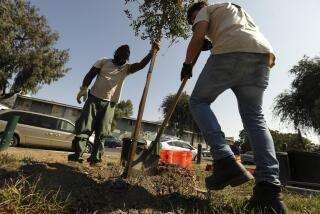A Cool Dividend
Parking under shade trees does more than keep thighs from sticking to vinyl seats--it may curb pollution.
The U.S. Forest Service meets today with the environmental group TreePeople and Los Angeles City Council staffers to discuss a recent study that suggests lowering vehicle temperatures with something as simple as shade slows gasoline evaporation from parked cars.
“Parking lots are a wasteland,” said Greg McPherson, the study’s leader. “They’re pollution hot spots. Yet people haven’t focused on them as a component of the urban ecosystem.”
TreePeople is hopeful the study will bolster its efforts to increase tree plantings in Los Angeles and create its envisioned “urban forest.” The city’s 2-year-old ordinance requiring 50% shade over parking lots within 10 years has been inconsistently enforced and only applies to the newest developments, as shopper Diane Wilson of Eagle Rock discovered Wednesday when she left an older--treeless--Northridge supermarket lot.
“The steering wheel and seat will be so hot,” said Wilson, 39, as she loaded bags of ice into a cooler of drinks for her son’s Little League team. “I have to wait for it to cool down.”
*
Straight out of a science fiction movie, noxious fumes waft from vehicle gas tanks under a searing red sun. The scene plays out daily in jammed parking spaces that checker the city. In fact, these harsh, heavily traveled environments take up about 10% of cities, according to the Forest Service.
The agency’s $30,000 study was the first to examine the relationship between shade and cars parked on asphalt, where temperatures can hit triple digits.
Forest Service researchers created weather stations within a typical parking lot in Davis to measure air temperature and wind speed. They compared temperatures in shaded and non-shaded areas.
Then, using an index from the California Air Resources Board--which measures hydrocarbon emissions at different temperatures--the researchers calculated pollution reduction. They concluded that increasing canopy coverage to 50% could reduce hydrocarbon emissions by nearly a ton per day throughout the greater Sacramento area.
Researchers have long known that shade trees cool outside air temperature by as much as 10 degrees and car interiors by 40 degrees. But less understood is that parked cars, not just moving vehicles, emit pollutants.
Like any liquid, gasoline evaporates as temperatures rise. The hotter the car, the higher the evaporation rate of gasoline and the release of hydrocarbons--the primary ingredient of ozone, which has been linked to smog and global warming.
Most solutions have targeted auto makers. Since the 1970s, carbon-activated canisters have been required on cars to capture and store gasoline vapors until the engine burns off the fumes.
*
Trees cannot completely clean up the problem, but they can help. Shade would help at the next stage--after cars have rolled off the assembly line and into sizzling parking lots. Environmental experts praise the strategy.
“It’s a constructive approach. It’s easy, as opposed to clamping down further on industry or the vehicles,” said Arthur Winer, director of UCLA’s environmental science and engineering program.
But others note that modest pollution reductions gained with trees might be outpaced by more stringent standards in store for car manufacturers, said a spokesman from the Clean Air Resources Board in El Monte.
Parked cars account for nearly a third of hydrocarbon emissions from motor vehicles. In the Southland, vehicles made up nearly half the total hydrocarbon emissions in 1997, according to the South Coast Air Quality Management District.
Since April 1996, the city has required trees in parking lots to reduce heat and glare: one tree to every four parking spaces. Within 10 years, the shade canopy must cover 50% of the parking lot stalls, said city planner Mike O’Brien.
Still, a majority of the city’s parking lots were paved before that ordinance was enacted. And some Los Angeles parking lots are rarely inspected after the design stage to ensure that the trees are planted. O’Brien acknowledged that under Los Angeles’ tree ordinance, inspectors are not supposed to check the parking lots until they are a decade old.
(BEGIN TEXT OF INFOBOX / INFOGRAPHIC)
Cleaner Air in the Shade
A U.S. Forest Service study suggests that increasing tree canopy cover reduces pollutantsemitted by parked cars. Pollution measurements were taken over a two-week period in Sacrameto.
*
Amount of tree canopy coverage
Test case: 8%
Hypothetical cases: 25% / 50%
*
Average daytime air temperature in parking ot
Test case: 93.6’ F
Hypothetical cases: 92.6’ F / 91.3’ F
*
Vehicle hydrocarbons emitted citywide in Sacramento parking lots, in tons per day.
Test case: 25.36
Hypothetical cases: 25.24 / 24.78
Source: United States Forest Service
More to Read
Sign up for Essential California
The most important California stories and recommendations in your inbox every morning.
You may occasionally receive promotional content from the Los Angeles Times.










